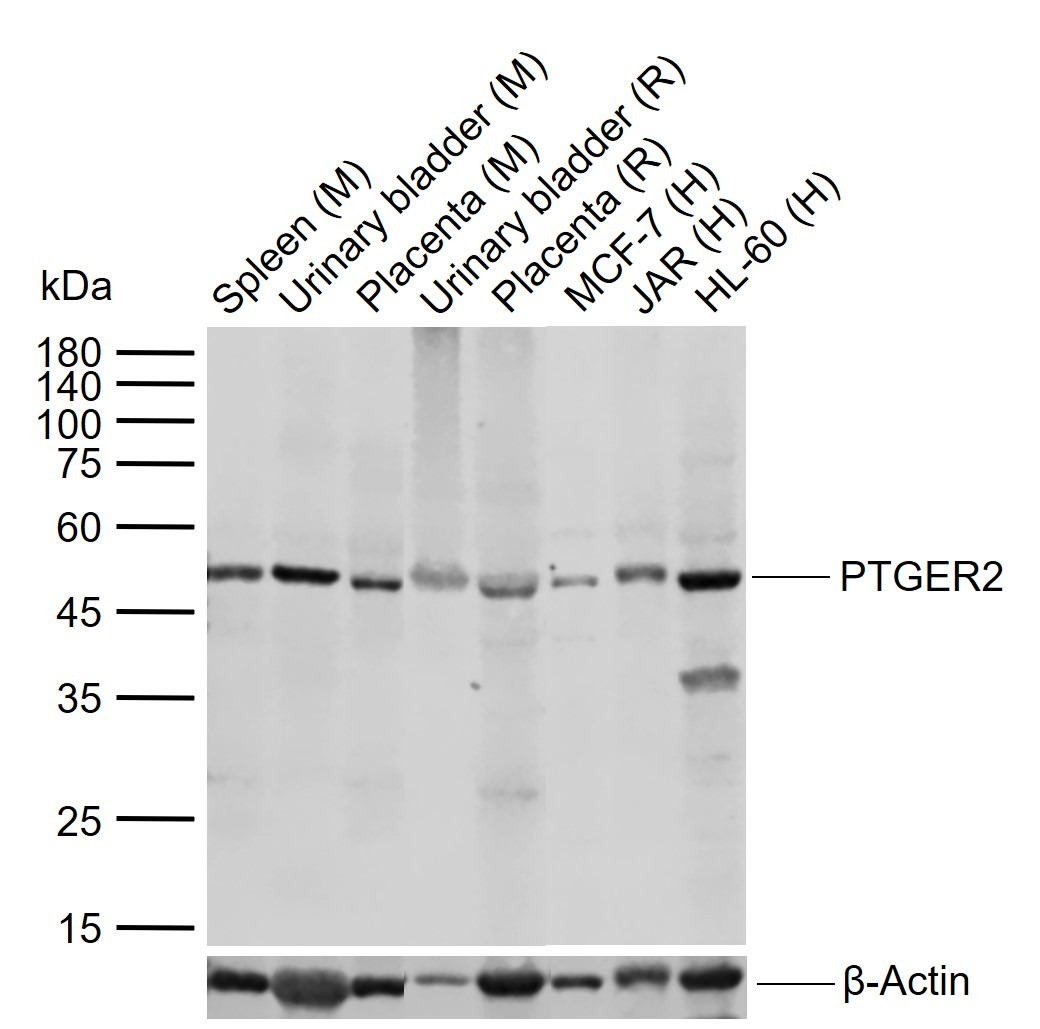Shopping Cart
Remove All Your shopping cart is currently empty
Your shopping cart is currently empty
Anti-PTGER2 Polyclonal Antibody is a Rabbit antibody targeting PTGER2. Anti-PTGER2 Polyclonal Antibody can be used in WB.
| Pack Size | Price | USA Warehouse | Global Warehouse | Quantity |
|---|---|---|---|---|
| 50 μL | $220 | 7-10 days | 7-10 days | |
| 100 μL | $372 | 7-10 days | 7-10 days | |
| 200 μL | $527 | 7-10 days | 7-10 days |
| Description | Anti-PTGER2 Polyclonal Antibody is a Rabbit antibody targeting PTGER2. Anti-PTGER2 Polyclonal Antibody can be used in WB. |
| Synonyms | PTGER 2, Prostanoid EP2 receptor, Prostaglandin E2 receptor EP2 subtype, PGE2 receptor EP2 subtype, PGE receptor EP2 subtype |
| Ig Type | IgG |
| Reactivity | Human,Mouse,Rat,Sheep (predicted:Dog,Pig,Cow,Rabbit) |
| Verified Activity | Sample: Lane 1: Mouse Spleen tissue lysates Lane 2: Mouse Urinary bladder tissue lysates Lane 3: Mouse Placenta tissue lysates Lane 4: Rat Urinary bladder tissue lysates Lane 5: Rat Placenta tissue lysates Lane 6: Human MCF-7 cell lysates Lane 7: Human JAR cell lysates Lane 8: Human HL60 cell lysates Primary: Anti-PTGER2 (TMAB-01592) at 1/1000 dilution Secondary: IRDye800CW Goat Anti-Rabbit IgG at 1/20000 dilution Predicted band size: 40 kDa Observed band size: 48 kDa  |
| Application | |
| Recommended Dose | WB: 1:500-2000 |
| Antibody Type | Polyclonal |
| Host Species | Rabbit |
| Subcellular Localization | Cell membrane; Multi-pass membrane protein. |
| Tissue Specificity | Placenta and lung. |
| Construction | Polyclonal Antibody |
| Purification | Protein A purified |
| Appearance | Liquid |
| Formulation | 0.01M TBS (pH7.4) with 1% BSA, 0.02% Proclin300 and 50% Glycerol. |
| Concentration | 1 mg/mL |
| Research Background | Prostaglandins are produced by the metabolism of arachidonic acid. Prostaglandin E2 is one of the five physiologically significant prostanoids known. Its wide spectrum of physiologic and pharmacologic effects in various tissues is mediated through binding to the Prostaglandin E2 receptors (EP1, EP2, EP3 & EP4). These include effects on the immune, endocrine, cardiovascular, renal and reproductive systems as well as smooth muscle. It is also one of the most abundant of the prostanoid family in the brain where it plays an important role in many neural functions, particularly in newborn babies, and as a mediator of inflammation. Prostaglandin E2 signals through a family of G-protein coupled receptors known as EP receptors. There are 4 subtypes of EP receptors, known as EP1, EP2, EP3 and EP4. EP2 receptors are 358 amino acid proteins with a short third intracellular loop. EP2 receptors stimulate adenylyl cyclase by their coupling to Gs and do not undergo Prostaglandin E2 induced internalization. The EP2 receptors is involved with the contration and relaxation of smooth muscle tissue. These receptors are mainly localized in lung and placental tissues and in smooth muscle. |
| Immunogen | KLH conjugated synthetic peptide: human Prostaglandin E Receptor EP2 |
| Antigen Species | Human |
| Gene Name | PTGER2 |
| Gene ID | |
| Protein Name | Prostaglandin E2 receptor EP2 subtype |
| Uniprot ID | |
| Biology Area | Lipid metabolism,Prostaglandins |
| Function | Receptor for prostaglandin E2 (PGE2). The activity of this receptor is mediated by G(s) proteins that stimulate adenylate cyclase. The subsequent raise in intracellular cAMP is responsible for the relaxing effect of this receptor on smooth muscle. |
| Molecular Weight | Theoretical: 40 kDa. |
| Stability & Storage | Store at -20°C or -80°C for 12 months. Avoid repeated freeze-thaw cycles. |
| Transport | Shipping with blue ice. |
| Size | Quantity | Unit Price | Amount | Operation |
|---|

Copyright © 2015-2025 TargetMol Chemicals Inc. All Rights Reserved.